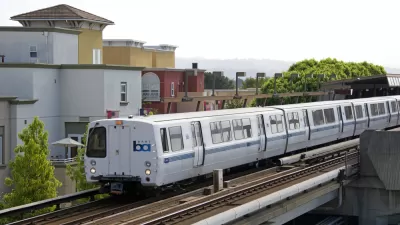BART trains have always made a lot of noise—impacting riders and the people who live along the regional system's routes. Now there's hope that the racket could be a thing of the past.

Aarian Marshall writes: "Some 44 years after BART opened, the transit agency has finally figured out how to tamp down the racket, and make life just a bit nicer for its 420,000 daily weekday riders: It’s shaving its metal wheels by two millimeters."
The solution followed research across four years, three contractors, and a year of testing according to Marshall, but the implementation is expected to be simple compared to some of the other big projects underway on the system.
Marshall also explains in more detail what made BART trains so noisy:
Turns out, it’s all about shape. The current round BART wheels sit on a fixed axle, so they don’t spin independently of one another. When the train turns, the outside wheels want to go faster than their inside counterparts, which get dragged along. This inside “slipping” not only makes extra noise—it warps the rails. Called “corrugation,” that damage makes the the [sic] goshdarn hubbub even worse.
In response, new BART wheels will be slightly tapered. Voila! Serenity.
Another benefit of the wheels that have been engineered to solve the problem: "BART expects the new shape to increase a wheel’s lifespan from three years to seven."
FULL STORY: The Four-Year Fight to Make San Francisco’s Subway Stop Screaming

Maui's Vacation Rental Debate Turns Ugly
Verbal attacks, misinformation campaigns and fistfights plague a high-stakes debate to convert thousands of vacation rentals into long-term housing.

Planetizen Federal Action Tracker
A weekly monitor of how Trump’s orders and actions are impacting planners and planning in America.

In Urban Planning, AI Prompting Could be the New Design Thinking
Creativity has long been key to great urban design. What if we see AI as our new creative partner?

Cal Fire Chatbot Fails to Answer Basic Questions
An AI chatbot designed to provide information about wildfires can’t answer questions about evacuation orders, among other problems.

What Happens if Trump Kills Section 8?
The Trump admin aims to slash federal rental aid by nearly half and shift distribution to states. Experts warn this could spike homelessness and destabilize communities nationwide.

Sean Duffy Targets Rainbow Crosswalks in Road Safety Efforts
Despite evidence that colorful crosswalks actually improve intersection safety — and the lack of almost any crosswalks at all on the nation’s most dangerous arterial roads — U.S. Transportation Secretary Duffy is calling on states to remove them.
Urban Design for Planners 1: Software Tools
This six-course series explores essential urban design concepts using open source software and equips planners with the tools they need to participate fully in the urban design process.
Planning for Universal Design
Learn the tools for implementing Universal Design in planning regulations.
Appalachian Highlands Housing Partners
Gallatin County Department of Planning & Community Development
Heyer Gruel & Associates PA
Mpact (founded as Rail~Volution)
City of Camden Redevelopment Agency
City of Astoria
City of Portland
City of Laramie





























